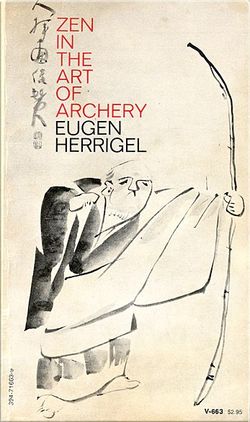A comment to the "Bright Spots" post from a reader named Catherine reminded me of a book I recommended several years ago in an Amazon "Listmania" list I put together one evening when I was bored* called "Readings for Practicing Photographers ." The book is Zen in the Art of Archery
." The book is Zen in the Art of Archery by Eugen Herrigel, and what I said about it then was "Make the mental leap from shooting arrows to shooting pictures, and
this becomes virtually an instruction manual for camera handling and
shooting skills."
by Eugen Herrigel, and what I said about it then was "Make the mental leap from shooting arrows to shooting pictures, and
this becomes virtually an instruction manual for camera handling and
shooting skills."
 Okay, now, cut it out—I can hear the scoffing from here. I know some people are going to dismiss out of hand the idea that a book like this could be useful, because the title has the word "zen" in it and they'll assume I'm being a navel-gazing lefty pinko arty-farty type again. Well, okay. But, still.
Okay, now, cut it out—I can hear the scoffing from here. I know some people are going to dismiss out of hand the idea that a book like this could be useful, because the title has the word "zen" in it and they'll assume I'm being a navel-gazing lefty pinko arty-farty type again. Well, okay. But, still.
This idea—applying Herrigel on archery to shooting with a camera—isn't mine. The book was assigned to my third-year class in photo school by Frank Diperna (another one of my many friends and mentors whose websites don't adequately reflect the richness and diversity of their work). I have a DiPerna—an 8x10" platinum print—hanging in my house.
I still find it apropos, lo these many years later. Although it might be one of those books which, if it appeals to you, you don't need. And the people who could really use it, it won't appeal to. To quote another friend and teacher, Paul Kennedy, "You know what they say...'oh well.'"
As far as Catherine's purpose in quoting Shunryu Suzuki—"In the beginner's mind there are many possibilities; in the expert's mind there are few"—is concerned, sympathizers with that view might be interested in reading about the anonymous "Bruces," who are mounting a small guerrilla struggle against the juggernaut of the University takeover of art practice (as opposed to art scholarship, which does belong in Universities). The article, written by Roberta Smith, begins as follows:
IN an often quoted remark the Abstract Expressionist Barnett Newman
once said, “Aesthetics is for artists what ornithology is for birds.” I
wonder what Newman would make of the overflow of M.F.A.-bearing
would-be artists pouring out of art schools and universities these
days. Maybe he’d say, “An artist without a graduate degree is like a
fish without a bicycle.”
I could segue from there to talking about how my bicycle shopping is going (hint—okay, and another hint), but that would be free-associating, and those who appreciate a semblance of order in their blog reading might object. To get back to the subject, I recommend you check out Eugen Herrigel, especially if the idea of doing so does not appeal to you.
Mike
*That was before I started The Online Photographer.
Send this post to a friend
Featured Comment by fotorr: "A Minor White favorite."
Featured Comment by Carl Weese: "Marksmanship training western style, without a Zen component, can be a great physical and mental aid to the physical aspects of shooting pictures. Things like squeezing off smooth exposures at slow speeds, or waiting for the perfect moment and then responding suddenly but smoothly, or following action, etc. By the way, Zen archery and western target archery have more in common than you might guess. For one thing, even when competing in tournaments for score, the well-trained marksman concentrates entirely on form, not scoring, while shooting. Really a very close parallel to the mental discipline of Zen archery."
Featured Comment by Vinegar Tom: "Interesting, the way the appropriation of the word "zen" by the Beat Generation has skewed our perception. Herrigel was, quite literally, a Nazi. The skills, mental attitudes and intense self-discipline of an aristocratic Japanese warrior caste may indeed help us hold a camera steady, but there's nothing inherently lefty pinko about them. Quite the reverse."
Featured Comment by Kirk Thompson: "According to Clement Cheroux, in his little book Henri Cartier-Bresson , NY: Abrams, n.d.: 'After the war and his long stay in Asia, during which he discovered Eastern religions, Cartier-Bresson made far less use of the hunting and firearms metaphor in describing his work. He preferred instead to compare it to archery. In the early 1950s, Georges Braque gave him a little book entitled Zen in the Art of Archery (1948), which was to have a major influence on his concept of photography, or at least on his way of describing it.... In this tiny work [by Eugen Herrigel], and particularly in its description of satori, a state of spiritual enlightenment, Cartier-Bresson found a notion of concentration that was astonishingly similar to his own practice: forgetting oneself, and putting all one's senses on alert in order to be able to seize on whatever offered itself.' (P. 108.)"
, NY: Abrams, n.d.: 'After the war and his long stay in Asia, during which he discovered Eastern religions, Cartier-Bresson made far less use of the hunting and firearms metaphor in describing his work. He preferred instead to compare it to archery. In the early 1950s, Georges Braque gave him a little book entitled Zen in the Art of Archery (1948), which was to have a major influence on his concept of photography, or at least on his way of describing it.... In this tiny work [by Eugen Herrigel], and particularly in its description of satori, a state of spiritual enlightenment, Cartier-Bresson found a notion of concentration that was astonishingly similar to his own practice: forgetting oneself, and putting all one's senses on alert in order to be able to seize on whatever offered itself.' (P. 108.)"
Featured Comment by Michael W: "The first paragraph of that Roberta Smith article was enough to put me off clicking through to read the full thing. First she refers to MFA grads as 'would-be artists' and that is patently inaccurate. There are many good artists with MFAs & it's unfair for her to insult all of them while trying to attack some. Secondly she re-uses the old feminist quote about fish and bicycle & sort of puts the words into Banett Newman's voice, 'Maybe he'd say' as if she can use a little of his authority to prop up her argument. Barnett Newman didn't say anything about MFA grads & it's dishonest to imply that she'd know what his opinion about it would be. So based on that I think I've saved myself from wasting my time reading any further. There may even be some important points to be made about the academisation of art study, but it doesn't seem that she is the writer who'll be making them."
Featured [partial] Comment by Alex Vesey: "...is [Zen in the Art of Archery] 'wrong' or 'false' as a spiritual guide? I would say 'not necessarily' to that question. One can accept the story's ideas as expressions of faith, and as an inspirational model. It is more like a hagiography (the tale of a saint or religious figure) than a biography (ostensibly a verifiable historical narrative), and should be read and used as such. How does this relate to photography? Zen training requires years of mental discipline to teach the mind to engage the the world and its transient dualities directly, yet without attachment. We are speaking of decades of effort. But anyone, including photographers, can receive inspiration from accounts of such training." [See Alex's entire comment in the Comments section.]
 Check out the Pentax K-x color simulator at the Japanese website (it can be slow to load but responds reasonably quickly once you're up and running). If you're going to offer colors, might as well go all the way....
Check out the Pentax K-x color simulator at the Japanese website (it can be slow to load but responds reasonably quickly once you're up and running). If you're going to offer colors, might as well go all the way.... Featured Comment by Ed Buziak: "I think Pentax are serious about this color program, and for good reason. I read the following on the OK1000 Pentax Blog whose owner (Michael) attended the Pentax Special Launch in New York on the 16th. He wrote '...Pentax received strong demographic numbers that showed that women bought more colored cameras than they would have bought black models. The numbers jumped from a skew of 20% female and 80% male buyers to 50%–50%. Something worth doing on a larger scale.'"
Featured Comment by Ed Buziak: "I think Pentax are serious about this color program, and for good reason. I read the following on the OK1000 Pentax Blog whose owner (Michael) attended the Pentax Special Launch in New York on the 16th. He wrote '...Pentax received strong demographic numbers that showed that women bought more colored cameras than they would have bought black models. The numbers jumped from a skew of 20% female and 80% male buyers to 50%–50%. Something worth doing on a larger scale.'"



